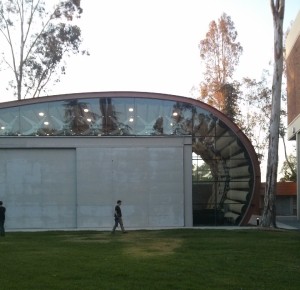 The 12th annual Dog Star series of concerts are in full swing all around Los Angeles and the venue for Sunday, June 5, 2016 was The Wild Beast, located on the Cal Arts campus. An evening of experimental music was presented in a concert titled The Theater of an Open Space and some 30 performers were on hand to realize reference works by John Cage, Manfred Werder and Pauline Oliveros. Additionally, two new pieces were presented by Casey Anderson and Todd Lerew.
The 12th annual Dog Star series of concerts are in full swing all around Los Angeles and the venue for Sunday, June 5, 2016 was The Wild Beast, located on the Cal Arts campus. An evening of experimental music was presented in a concert titled The Theater of an Open Space and some 30 performers were on hand to realize reference works by John Cage, Manfred Werder and Pauline Oliveros. Additionally, two new pieces were presented by Casey Anderson and Todd Lerew.
The first half of the concert consisted of four complimentary works given serially and without pause. Four segments of Variations IV, by John Cage formed a framework while From Unknown Silences by Pauline Oliveros, 20121 by Manfred Werder and 0’00”, also by Cage, were woven neatly into the continuous 32 minute performance. The first segment of Variations IV began with the players of the ‘orchestra’ arranged around the interior of The Beast according to a drawing a the center showing lines of direction and spatial locations. The players followed a timed score and at various intervals certain familiar pitched or non-pitched sounds were heard – the rap of a hammer, a ringing alarm clock, a coffee mug vigorously stirred or the knocking of rocks together – and suchlike. These sounds were separated by a few seconds of silence. Sometimes the player would move towards the center while performing – then return – and sometimes the sounds from two or more players overlapped.
At first the familiarity of these sounds evoked their normal mundane context in the mind of the listener. As the sequences were repeated, however, and especially the ones that involved movement of the players toward the center, the proceedings acquired a more ceremonial character. The movement of the players became choreography and the actions took on an imagined symbolic character. All of the segments of Variations IV had a similar pattern, but with some minor modifications involving the number of sounds heard concurrently or the number of players in motion. From Unknown Silences, the Oliveros piece, fit perfectly within this framework with a similar sequence of independent sounds, preceded and followed by periods of silence. The feeling here was perhaps more introspective and acute. Cage asks us to consider familiar sounds in the context of performance; Pauline Oliveros invites us to listen deeply to solitary sounds, processing them in the silence that follows. The two works intertwined seamlessly.
At about the midpoint the players rose and gathered together in the center, exchanging scores they had written during the first half, and this action marked both the Manfred Werder contribution and the 0’00” portion of the program. The last two sections of Variations IV followed these new instructions, with the materials and form similar to the opening. All of this was a bit reminiscent of Water Walk – another Cage composition – that asked us to evaluate ordinary sounds in a musical context. Variations IV aims for same sensibility, but from the perspective of the familiar as ritual. This was ably expressed by the 30 performing players of the orchestra.